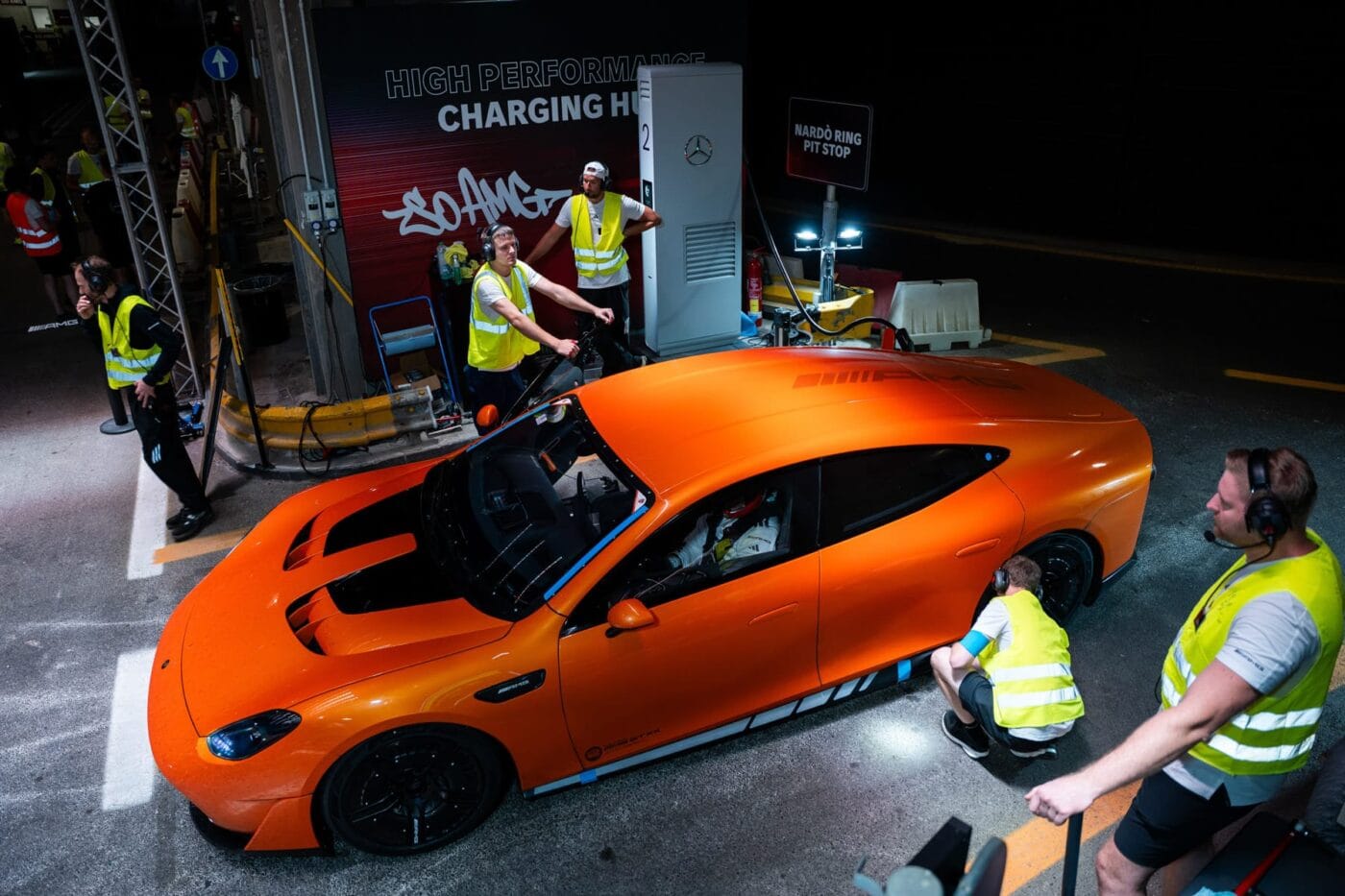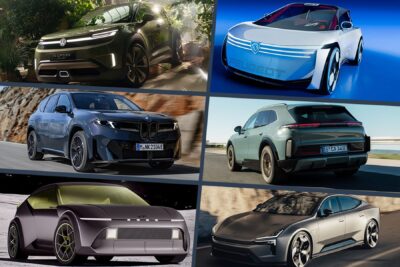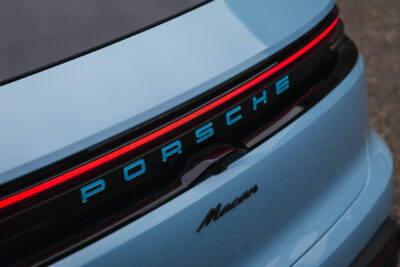Mercedes reveals further details about record-breaking electric drive
Mercedes set a total of 25 records when two prototypes of the Concept AMG GT XX took to the legendary test track in Nardò at the end of August. When the first vehicle had covered 40,075 kilometres, the circumference of the Earth at the equator, the second vehicle was only 25 kilometres behind. The optimum cruising speed was 300 kph, with corresponding demands on the technology.
According to Mercedes, this extreme stress test was only possible thanks to the endurance performance of the drive concept. Numerous other innovations, some of which are close to series production, also contributed to the successful extreme test. The focus was on the integrated cooling concept, sophisticated aerodynamics and intelligent operating strategy, among other things.
Two examples: the prototypes were equipped with axial flow motors (three per vehicle) from Mercedes subsidiary Yasa and a directly cooled battery, “technologies that will go into series production next year in the AMG.EA high-performance architecture,” according to Mercedes.
Numerous simulations had already determined the optimal strategy for the extreme journey in advance, for example, the ideal driving speed of 300 kph with the best balance between speed and efficiency. The vehicle is specified for speeds of up to 360 kph, but this would have led to a disproportionate increase in consumption. Over several simulation cycles, the results were first validated and improved step by step on the test bench (down to the battery cell level) and later with data from the test track.
850 kW charging power on Alpitronic prototype
In addition, simulation experts from the Formula 1 engine division Mercedes-AMG High Performance Powertrains (HPP) developed a tool that could compare the pre-calculated operating strategy live with the conditions on site. In other words, during the record-breaking drive, all data was transmitted to the ‘Mission Control Truck’ and analysed in real time, whether external factors such as temperature and wind, dirt on the road or tyre wear had an influence on the drive and vehicle components. This meant that the strategy could be continuously adjusted during the drive, which lasted several days, for example, the length of the individual stints until the next charging stop.
In addition to achieving the best possible travel speed with low fuel consumption, charging stops were naturally also a key factor in the record-breaking journey – the longer the vehicle stands still, the more time is lost. Mercedes opted to collaborate with South Tyrolean charging station manufacturer Alpitronic in order to optimise the coordination between the vehicle and the charging station as part of a holistic development approach. On a test bench in Stuttgart-Untertürkheim, the development team simulated real-life charging scenarios in which vehicle components and charging stations were tested and validated together.
Not only is the Concept AMG GT XX a prototype that is not available for purchase, but the charging station is also not available on the market in this form. While commercially available CCS charging points are designed for 500 amps (and only reach higher peaks for short periods), the Alpitronic prototype can transmit currents of up to 1000 amps via a standard CCS cable. To make this possible, Alpitronic engineers used an MCS dispenser originally designed for trucks and replaced the MCS cable with a CCS cable with improved cooling. This allowed the vehicles to be charged at an average of 850 kW, several times in a row.
For the record-breaking journey, however, such a charging system also had to be set up on the test track in southern Italy, including medium-voltage power lines and transformers. The new grid connection was designed directly for three chargers with a total output of over 2.5 megawatts. The Mercedes-Benz Charging Unit, which is setting up Mercedes’ global fast-charging network, was also involved in the installation, which took just under three months from the building application to commissioning.
“The results underline the role of this project as a test laboratory: the valuable insights gained under extreme conditions will be transferred into our series products,” Alpitronic wrote in a LinkedIn post. “The tests confirmed that very high charging power is technically feasible and that charging times are getting closer to the refueling experience, which directly supports the broader acceptance of electromobility.”
However, such enormous charging capacities must also be able to be absorbed by the vehicles and their batteries; electric trucks with their large batteries are already capable of this to some extent, as various MCS charging tests show. In electric cars with smaller batteries, however, charging capacities of 850 kW pose challenges – especially for the cooling system.
Innovative cooling concept
“Powerful cooling is essential to delivering the sustained power of the CONCEPT AMG GT XX,” writes Mercedes, referring to the “innovative direct liquid cooling of the high-performance battery.” Added to this is the cooling of the motors and their inverters, as well as the so-called ‘Onebox’, which combines the power electronics for the 12-volt electrical system and the on-board charger. The challenge: all components require different temperatures. Mercedes has therefore developed a ‘Central Coolant Hub’ (CCH), which, according to the press release, is the ‘mastermind’ of the vehicle’s cooling system. The highly integrated component, which is installed between the electric motor on the front axle and the longitudinal member of the body, comprises high-performance cooling pumps, temperature sensors and 4- and 5-way valves.
“The major advantage of this cooling system lies in its ability, in combination with the axial-flux motors and directly cooled battery, to deliver full performance in virtually any situation – whether driving or charging,” Mercedes writes. “For example, after high-speed driving in hot conditions, the system allows immediate access to maximum charging power. Conversely, following a high-speed charging session, exceptional driving performance is instantly available.”
Part of the cooling concept is also a passive cooling plate at the front of the underbody, as already tested in the Vision EQXX. This ‘permanently flowed underbody cooling plate’ is designed to help relieve the main radiator to such an extent that the air control system can remain closed over long distances. Some aerodynamic elements have also been designed to support the cooling system. Overall, efficient aerodynamics are important because, at 300 kph, around 83 per cent of the drive energy is used to overcome air resistance, as Mercedes calculates. With many individual measures, the cW value has been reduced to 0.19. ‘The improvement of just 1 point (= cW reduced by 0.001) had a similar effect on range and efficiency as a weight saving of around 90 kilograms,’ writes Mercedes.
BMS can model cell behaviour
While the aerodynamics of the sports car cannot be directly transferred to more everyday production models, Mercedes engineers have done a lot of groundwork to optimise the technology of the Concept AMG GT XX for the record-breaking drive, which will also be incorporated into series development in the future, for example, in the battery.
The ideal solution for battery management would be to measure the processes at the core of each cell directly, but this is not possible. The team therefore used specially modified cells and sensors, known as reference electrodes, in advance to learn how the cells behave during use. The collected data was then fed into the battery management software, which should enable better modelling of cell behaviour, not only in the Concept AMG GT XX, but also in other vehicles with these cells. For production cars with other cells, the reference electrode method can be transferred.
mercedes-benz.com, linkedin.com
This article was first published by Sebastian Schaal for electrive’s German edition.





0 Comments